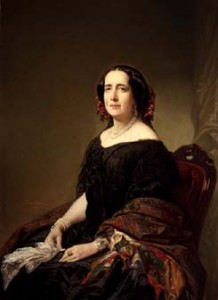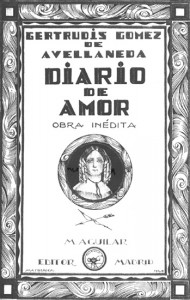If Jose Maria Heredia (1803-1839) and José Martí (1853-1895) live on for their poetry of patriotic concerns, Gertrudis Gómez de Avellaneda (Camaguey, 1814-Madrid, 1873) slipped into immortality for her lyrical, narrative and theatrical contributions. The three were a kind of tropical cyclone that converged on the tongue in the nineteenth century; though they didn’t coincide on the map of the island. She admired Heredia and went to Niagara Falls to evoke him with another Oda. Meanwhile José Martí binds them in their differences and rescues them as symbols of the nation that works.
Gertrudis Gómez de Avellaneda was like a mirror superimposed on horizons. For her, Spain was the promised dream of her Andalusian father, the home of ancestors who knew how to lift the drowsy parochialism. She left with her family in April 1836. Her sonnet Leaving is a cry of love and Cubanness, an expression of the uprooting and anticipation that accompanied her to the Peninsula, where she established himself independently in spite of prejudice and ethical and social conventions. Her life ranged from Cadiz, Seville and Madrid, in a succession of creative goals and personal passions, against the grain of cultural otherness and her native condition: a beautiful criolla, rebellious and cultured.
This writer with the fascinating personality, complex and authentic, sensitive, and talented, breached the nineteenth century hierarchy and the patriarchal ideology to establish herself in the cultural field of Spain through the press, printing and theater stages. She signed her poems with the pseudonym “La Peregrina,” The Pilgrim. Her loving correspondence is a cultural heritage of human depth and pre-feminist affirmation, a theme that runs through her dramas, comedies and stories, in which women compete with other characters and drive the plot.
 Avellaneda’s literary profile falls within the Spanish context of early romanticism. Her first publications were poems which started to appear in 1838 in the newspapers and magazines of Andalusian cities. Critics say that the originality of her frame of mind exceeded the thematic and stylistic expectations of feminine writing of that era. Fame surprised her when her tragedy Leoncia was released in Cadiz, Granada and Seville, although she excelled in drama, comedy, novels, and poetry, and wrote essays and letters that recreate certain keys of her lyrical, passionate relationships and dramatic characters that populated her imagination.
Avellaneda’s literary profile falls within the Spanish context of early romanticism. Her first publications were poems which started to appear in 1838 in the newspapers and magazines of Andalusian cities. Critics say that the originality of her frame of mind exceeded the thematic and stylistic expectations of feminine writing of that era. Fame surprised her when her tragedy Leoncia was released in Cadiz, Granada and Seville, although she excelled in drama, comedy, novels, and poetry, and wrote essays and letters that recreate certain keys of her lyrical, passionate relationships and dramatic characters that populated her imagination.
In 1841 she published her first volume of poems and her novel Sab, inspired by a young slave, black and virtuous. These were followed by the novel Two Women (1842), banned in Cuba as was Sab; the stories Espatolino, The Baroness de Joux, and the Biography of the Countess of Merlin; and the dramas Alfonso Munio and Prince of Viana, all in 1844, for which she was honored by the Liceo de Madrid — which gave prizes to two of her poems — and the Laurel Crown, and she was named to the Society of Merit. Between 1844 and 1858 she also published the drama Egilona, an autobiographical article for the Mellado Dictionary of History and Geography, the novel Guatimozin, The Last Emperor of Mexico, and the second enlarged edition of her Poems. Meanwhile her other works premiered: Saul, Flavio Recaredo, The Truth Wins Appearances, The Daughter of Flowers, Errors of the Heart, and Balthazar; as well as the comedies, Like and Dislike, The Daughter of King René, The Oracle of Thalia and The Millionaire and the Suitcase, These were well represented in Cuba where she returned in 1859 with her second husband, the Spanish official Domingo Verdugo, who witnessed two extraliterary failures of his wife: her rejection for membership to the Royal Spanish Academy of Language (1853); and the staging of the play The Three Lovers, which led to scandals and duels. She also left us with the unpublished work, The Diary of Love.
 During her second stay on the island (1859-1864), she continued the intense social and intellectual life she had enjoyed in the cities in Spain. She is honored in her birthplace of Camaguey, and in Matanzas, Cárdenas and the Tacón Theater of in Havana, where the poet Luisa Perez de Zambrana offered a laurel wreath carved in gold, on behalf of the capital’s intelligentsia; meanwhile in Cienfuegos the Avellaneda Theatre is named after her.
During her second stay on the island (1859-1864), she continued the intense social and intellectual life she had enjoyed in the cities in Spain. She is honored in her birthplace of Camaguey, and in Matanzas, Cárdenas and the Tacón Theater of in Havana, where the poet Luisa Perez de Zambrana offered a laurel wreath carved in gold, on behalf of the capital’s intelligentsia; meanwhile in Cienfuegos the Avellaneda Theatre is named after her.
In 1860 she founded the Cuban Album Review of the Good and the Beautiful, directed and written in collaboration with renowned countrymen who shook the cultural and literary torpor of the island. In 1863 she published the novel The Boatman Artist, and immersed herself in grief at the death of her husband, who was then the head of the Government in Pinar del Rio, a position he held earlier in Cienfuegos and Cardenas. She returned to Madrid, where she dedicated her last years to preparing her Collected Works.
Gertrudis Gómez de Avellaneda, one of the leading voices of letters in Latin America, has been widely studied by the critics. Experts believe that her main contribution lies in the domain of the metric, because she cultivated all types of verses from the rhythmic arsenal of the neoclassical to the Romanesque. They say that she was influential in the theater among Spanish playwrights of her generation; but not in Cuba, where her works were less frequently staged and seen as part of the work coming from the mainland; but her impact on the island is in her poetry and prose, with its historical-biographical and reflexive character, despite the fact that poetry here was then more intimate than the novel and expressive lines of La Peregrina.
For her excellence, breadth and sense of renewal, the work of Avellaneda still moves the sensibilities of those who approach her writing. Her subtle spirit, her innate pride and the rebellion voiced in her poems, novels and dramatic characters, seem to gallop in the stillness of the treasured books in the library collections of Cuba and Spain.
October 3, 2010
